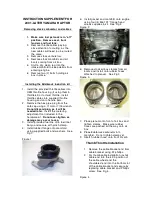
DRIVER SUPPORT
}}
351
bicycle outline, requiring the ability to identify the
bicycle, head, arms, shoulders, legs, upper and
lower body plus a normal human pattern of move-
ment.
If large parts of the cyclist's body or bicycle are
not visible to the function's camera then the sys-
tem cannot detect a cyclist.
For the function to be able to detect a cyclist,
he/she must be an adult and riding a bicycle
designed for adults.
WARNING
City Safety is supplementary driver support,
but it cannot detect all cyclists in all situations
and, for example, cannot see:
•
partially obscured cyclists.
•
cyclists if the background contrast of the
cyclist is poor – warning and brake inter-
ventions may then be late or not occur at
all.
•
cyclists wearing clothing that obscures
the body outline.
•
bicycles loaded with large objects.
The driver is always responsible that the vehi-
cle is driven correctly and with a safety dis-
tance adapted to the speed.
Pedestrians
Optimal examples of what the system regards as pedes-
trians with clear body outlines.
For optimal performance, the system function
that detects pedestrians must receive the clear-
est possible information about the body outline,
requiring the ability to identify the head, arms,
shoulders, legs, upper and lower body plus a nor-
mal human pattern of movement.
In order that it shall be possible to detect a
pedestrian there must be a contrast with the
background and this will be affected by such
things as clothes, the background and the
weather. With poor contrast the pedestrian may
either be detected late or not at all, which may
mean that warnings and braking are late or omit-
ted.
City Safety can also detect pedestrians in the
dark if they are illuminated by the car's head-
lamps.
WARNING
City Safety is supplementary driver support,
but it cannot detect all pedestrians in all sit-
uations and, for example, cannot see:
•
partially obscured pedestrians, people in
clothing that hides their body contour or
pedestrians shorter than 80 cm (32 in.).
•
pedestrians if the background contrast of
the pedestrians is poor - warning and
brake interventions may then be late or
not occur at all.
•
pedestrians who are carrying larger
objects.
The driver is always responsible that the vehi-
cle is driven correctly and with a safety dis-
tance adapted to the speed.
Summary of Contents for XC90 Twin Engine 2019
Page 1: ...XC90 T W I N E N G I N E OWNER S MANUAL...
Page 2: ......
Page 17: ...OWNER S INFORMATION...
Page 26: ......
Page 27: ...YOUR VOLVO...
Page 32: ...YOUR VOLVO 30 The owner s manual and the environment p 23 Air quality p 204...
Page 42: ......
Page 43: ...SAFETY...
Page 70: ...SAFETY 68 Table for location of ISOFIX child seats p 71 Seatbelts p 44...
Page 81: ...DISPLAYS AND VOICE CONTROL...
Page 151: ...LIGHTING...
Page 165: ...WINDOWS GLASS AND MIRRORS...
Page 183: ...SEATS AND STEERING WHEEL...
Page 203: ...CLIMATE...
Page 244: ......
Page 245: ...KEY LOCKS AND ALARM...
Page 265: ...KEY LOCKS AND ALARM 263 Country Area Type approval Oman Serbia...
Page 268: ...KEY LOCKS AND ALARM 266 Country Area Type approval Oman Serbia...
Page 290: ......
Page 291: ...DRIVER SUPPORT...
Page 416: ......
Page 417: ...HYBRID INFORMATION...
Page 433: ...HYBRID INFORMATION 431 LED lamp 1 LED lamp 2...
Page 445: ...STARTING AND DRIVING...
Page 510: ......
Page 511: ...SOUND MEDIA AND INTERNET...
Page 565: ...WHEELS AND TYRES...
Page 591: ...LOADING STORAGE AND PASSENGER COMPARTMENT...
Page 610: ......
Page 611: ...MAINTENANCE AND SERVICE...
Page 635: ...MAINTENANCE AND SERVICE 633 Fuses in engine compartment p 634 Fuses under glovebox p 638...
Page 664: ......
Page 665: ...SPECIFICATIONS...
Page 699: ......
Page 700: ...TP 27080 English Int AT 1846 MY19 Copyright 2000 2018 Volvo Car Corporation...
















































